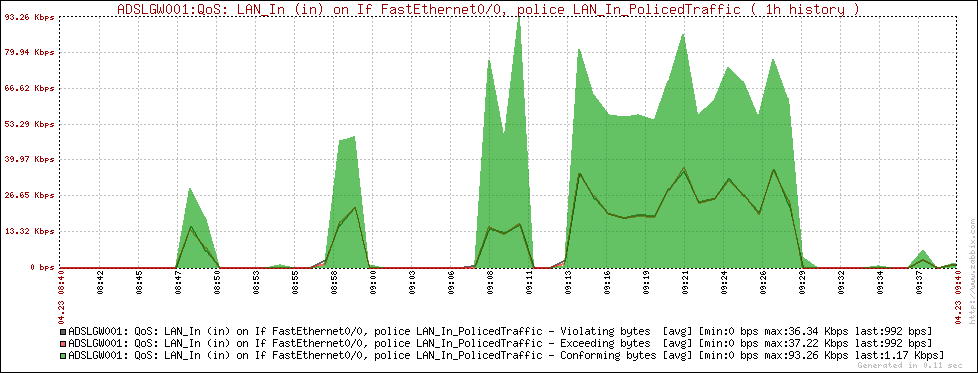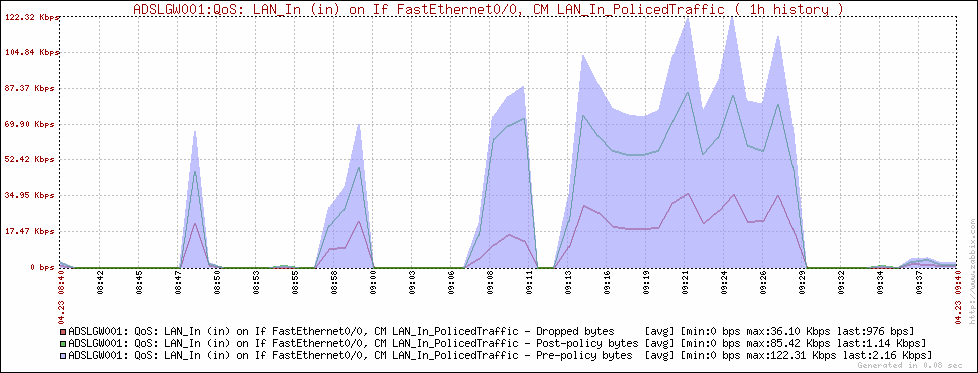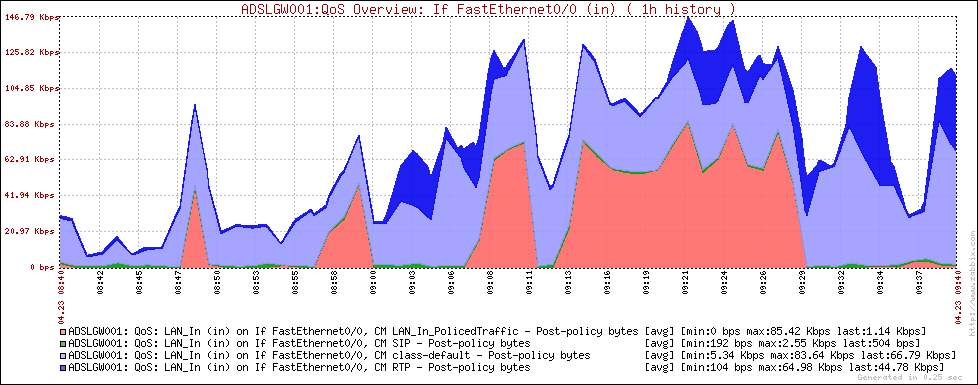As stated in the official CISCO-CLASS-BASED-QOS-MIB file, Cisco Class-Based QoS MIB “provides read access to Quality of Service (QoS) configuration and statistics information for Cisco platforms that support the Modular Quality of Service Command-line Interface“.
In other words, the integration of this MIB in a SNMP-based NMS lets you to monitor all the values you can see with the show policy-map IOS command.
This MIB has not a so straightforward structure as other MIBs have, so integration with NMS can be a little diffcult.
Let’s take a deeper look at its structure; in a future post I’ll show how to use this information to monitor IOS QoS statistics in Zabbix.
We’ll use the following trivial IOS configuration for our examples:
class-map match-any NonLocal
match access-group 10
!
class-map match-all ICMP
match protocol icmp
!
policy-map CPP
description Applied to control plan - In
class NonLocal
police cir 8000
conform-action transmit
exceed-action drop
!
policy-map LAN_Out
description Applied to fa0/0 - Out
class ICMP
bandwidth 10
class class-default
fair-queue
!
interface FastEthernet0/0
ip address 192.168.0.8 255.255.255.0
service-policy output LAN_Out
!
access-list 10 deny 192.168.0.0 0.0.0.255
access-list 10 permit any
!
control-plane
service-policy input CPP
In this MIB informations are stored on a lot of tables:
- cbQosServicePolicyTable and cbQosObjectsTable define QoS policies layout;
- cbQosXXXCfgTable tables define configuration details for the objects (ClassMap, PolicyMap, Match statements…);
- cbQosXXXStatsTable tables define runtime statistics for the same objects.
As first, we have to look at cbQosServicePolicyTable: here we find bindings between policy-maps and interfaces, as in the service-policy command:
cbQosServicePolicyTable
-----------------------
# snmpwalk -v 2c -c public -m ALL 192.168.0.8 .1.3.6.1.4.1.9.9.166.1.1.1
CISCO-CLASS-BASED-QOS-MIB::cbQosIfType.1043 = INTEGER: mainInterface(1)
CISCO-CLASS-BASED-QOS-MIB::cbQosIfType.1099 = INTEGER: controlPlane(5)
CISCO-CLASS-BASED-QOS-MIB::cbQosPolicyDirection.1043 = INTEGER: output(2)
CISCO-CLASS-BASED-QOS-MIB::cbQosPolicyDirection.1099 = INTEGER: input(1)
CISCO-CLASS-BASED-QOS-MIB::cbQosIfIndex.1043 = INTEGER: 1
CISCO-CLASS-BASED-QOS-MIB::cbQosIfIndex.1099 = INTEGER: 1
CISCO-CLASS-BASED-QOS-MIB::cbQosFrDLCI.1043 = INTEGER: 0
CISCO-CLASS-BASED-QOS-MIB::cbQosFrDLCI.1099 = INTEGER: 0
CISCO-CLASS-BASED-QOS-MIB::cbQosAtmVPI.1043 = Gauge32: 0
CISCO-CLASS-BASED-QOS-MIB::cbQosAtmVPI.1099 = Gauge32: 0
CISCO-CLASS-BASED-QOS-MIB::cbQosAtmVCI.1043 = Gauge32: 0
CISCO-CLASS-BASED-QOS-MIB::cbQosAtmVCI.1099 = Gauge32: 0
CISCO-CLASS-BASED-QOS-MIB::cbQosEntityIndex.1043 = INTEGER: 0
CISCO-CLASS-BASED-QOS-MIB::cbQosEntityIndex.1099 = INTEGER: 0
cbQosPolicyIndex is the table’s index (1043, 1099 in the previous example); it identifies the service-policy.
cbQosIfType defines the type of interface which the service-policy is applied to: mainInterface(1), subInterface(2), frDLCI(3), atmPVC(4), controlPlane(5), vlanPort(6).
cbQosPolicyDirection tells the direction of the traffic: input(1) and output(2).
Other parameters depend on cbQosIfType value and represent specific objects identifiers (ifIndex, DLCI, VPI/VCI, … ).
From the previous example we can see there are 2 service-policies, with ID 1043 and 1099, applied for output traffic to a physical interface with ifIndex 1, and for input traffic to the control-plane.
The second important table is cbQosObjectsTable, where all objects (class-map, match, set statements…) are stored, classified (cbQosObjectsType), identified within the configuration (cbQosConfigIndex) and related to the service-policy or other objects (cbQosParentObjectsIndex). Here we have a two-fields index: cbQosPolicyIndex and cbQosObjectsIndex:
cbQosObjectsTable
-----------------
# snmpwalk -v 2c -c public -m ALL 192.168.0.8 .1.3.6.1.4.1.9.9.166.1.5.1
CISCO-CLASS-BASED-QOS-MIB::cbQosConfigIndex.1043.1043 = Gauge32: 1035
CISCO-CLASS-BASED-QOS-MIB::cbQosConfigIndex.1043.1045 = Gauge32: 1029
CISCO-CLASS-BASED-QOS-MIB::cbQosConfigIndex.1043.1047 = Gauge32: 1033
CISCO-CLASS-BASED-QOS-MIB::cbQosConfigIndex.1043.1049 = Gauge32: 1037
CISCO-CLASS-BASED-QOS-MIB::cbQosConfigIndex.1043.1051 = Gauge32: 1025
CISCO-CLASS-BASED-QOS-MIB::cbQosConfigIndex.1043.1053 = Gauge32: 1027
CISCO-CLASS-BASED-QOS-MIB::cbQosConfigIndex.1043.1085 = Gauge32: 1079
CISCO-CLASS-BASED-QOS-MIB::cbQosConfigIndex.1099.1099 = Gauge32: 1063
CISCO-CLASS-BASED-QOS-MIB::cbQosConfigIndex.1099.1101 = Gauge32: 1057
CISCO-CLASS-BASED-QOS-MIB::cbQosConfigIndex.1099.1103 = Gauge32: 1061
CISCO-CLASS-BASED-QOS-MIB::cbQosConfigIndex.1099.1105 = Gauge32: 1065
CISCO-CLASS-BASED-QOS-MIB::cbQosConfigIndex.1099.1107 = Gauge32: 1025
CISCO-CLASS-BASED-QOS-MIB::cbQosConfigIndex.1099.1109 = Gauge32: 1027
CISCO-CLASS-BASED-QOS-MIB::cbQosObjectsType.1043.1043 = INTEGER: policymap(1)
CISCO-CLASS-BASED-QOS-MIB::cbQosObjectsType.1043.1045 = INTEGER: classmap(2)
CISCO-CLASS-BASED-QOS-MIB::cbQosObjectsType.1043.1047 = INTEGER: matchStatement(3)
CISCO-CLASS-BASED-QOS-MIB::cbQosObjectsType.1043.1049 = INTEGER: queueing(4)
CISCO-CLASS-BASED-QOS-MIB::cbQosObjectsType.1043.1051 = INTEGER: classmap(2)
CISCO-CLASS-BASED-QOS-MIB::cbQosObjectsType.1043.1053 = INTEGER: matchStatement(3)
CISCO-CLASS-BASED-QOS-MIB::cbQosObjectsType.1043.1085 = INTEGER: queueing(4)
CISCO-CLASS-BASED-QOS-MIB::cbQosObjectsType.1099.1099 = INTEGER: policymap(1)
CISCO-CLASS-BASED-QOS-MIB::cbQosObjectsType.1099.1101 = INTEGER: classmap(2)
CISCO-CLASS-BASED-QOS-MIB::cbQosObjectsType.1099.1103 = INTEGER: matchStatement(3)
CISCO-CLASS-BASED-QOS-MIB::cbQosObjectsType.1099.1105 = INTEGER: police(7)
CISCO-CLASS-BASED-QOS-MIB::cbQosObjectsType.1099.1107 = INTEGER: classmap(2)
CISCO-CLASS-BASED-QOS-MIB::cbQosObjectsType.1099.1109 = INTEGER: matchStatement(3)
CISCO-CLASS-BASED-QOS-MIB::cbQosParentObjectsIndex.1043.1043 = Gauge32: 0
CISCO-CLASS-BASED-QOS-MIB::cbQosParentObjectsIndex.1043.1045 = Gauge32: 1043
CISCO-CLASS-BASED-QOS-MIB::cbQosParentObjectsIndex.1043.1047 = Gauge32: 1045
CISCO-CLASS-BASED-QOS-MIB::cbQosParentObjectsIndex.1043.1049 = Gauge32: 1045
CISCO-CLASS-BASED-QOS-MIB::cbQosParentObjectsIndex.1043.1051 = Gauge32: 1043
CISCO-CLASS-BASED-QOS-MIB::cbQosParentObjectsIndex.1043.1053 = Gauge32: 1051
CISCO-CLASS-BASED-QOS-MIB::cbQosParentObjectsIndex.1043.1085 = Gauge32: 1051
CISCO-CLASS-BASED-QOS-MIB::cbQosParentObjectsIndex.1099.1099 = Gauge32: 0
CISCO-CLASS-BASED-QOS-MIB::cbQosParentObjectsIndex.1099.1101 = Gauge32: 1099
CISCO-CLASS-BASED-QOS-MIB::cbQosParentObjectsIndex.1099.1103 = Gauge32: 1101
CISCO-CLASS-BASED-QOS-MIB::cbQosParentObjectsIndex.1099.1105 = Gauge32: 1101
CISCO-CLASS-BASED-QOS-MIB::cbQosParentObjectsIndex.1099.1107 = Gauge32: 1099
CISCO-CLASS-BASED-QOS-MIB::cbQosParentObjectsIndex.1099.1109 = Gauge32: 1107
cbQosConfigIndex let us to find configuration details about objects in other tables; service-policies have the same cbQosObjectsIndex as cbQosPolicyIndex. These config tables are cbQosObjectsType dependent: we have cbQosPolicyMapCfgTable, cbQosClassMapCfgTable, cbQosMatchStmtCfgTable… each object type has its own table, all referenced by cbQosConfigIndex.
Let’s see one of them…
cbQosPolicyMapCfgTable
----------------------
# snmpwalk -v 2c -c public -m ALL 192.168.0.8 .1.3.6.1.4.1.9.9.166.1.6.1
CISCO-CLASS-BASED-QOS-MIB::cbQosPolicyMapName.1035 = STRING: LAN_Out
CISCO-CLASS-BASED-QOS-MIB::cbQosPolicyMapName.1063 = STRING: CPP
CISCO-CLASS-BASED-QOS-MIB::cbQosPolicyMapDesc.1035 = STRING: Applied to fa0/0 - Out
CISCO-CLASS-BASED-QOS-MIB::cbQosPolicyMapDesc.1063 = STRING: Applied to control plan - In
We can see here our policy-maps, indexed by the cbQosConfigIndex values previously found on cbQosObjectsTable.
With the cbQosObjectsTable data we already have all informations we need to build an OID list for our NMS.
Assume we just need to monitor class-map offered rate and drop rate, as in the show policy-map interface | inc Class-map|offered. All per class-map statistics are collected on the cbQosCMStatsTable; as all stats table, it’s indexed by cbQosPolicyIndex and cbQosObjectsIndex. Take a look at the table:
cbQosCMStatsTable
-----------------
# snmpwalk -v 2c -c public -m ALL 192.168.0.8 .1.3.6.1.4.1.9.9.166.1.15.1.1
CISCO-CLASS-BASED-QOS-MIB::cbQosCMPrePolicyPktOverflow.1043.1045 = Counter32: 0
CISCO-CLASS-BASED-QOS-MIB::cbQosCMPrePolicyPktOverflow.1043.1051 = Counter32: 0
CISCO-CLASS-BASED-QOS-MIB::cbQosCMPrePolicyPktOverflow.1099.1101 = Counter32: 0
CISCO-CLASS-BASED-QOS-MIB::cbQosCMPrePolicyPktOverflow.1099.1107 = Counter32: 0
CISCO-CLASS-BASED-QOS-MIB::cbQosCMPrePolicyPkt.1043.1045 = Counter32: 8
CISCO-CLASS-BASED-QOS-MIB::cbQosCMPrePolicyPkt.1043.1051 = Counter32: 1131
CISCO-CLASS-BASED-QOS-MIB::cbQosCMPrePolicyPkt.1099.1101 = Counter32: 281
CISCO-CLASS-BASED-QOS-MIB::cbQosCMPrePolicyPkt.1099.1107 = Counter32: 7016
CISCO-CLASS-BASED-QOS-MIB::cbQosCMPrePolicyPkt64.1043.1045 = Counter64: 8
CISCO-CLASS-BASED-QOS-MIB::cbQosCMPrePolicyPkt64.1043.1051 = Counter64: 1131
CISCO-CLASS-BASED-QOS-MIB::cbQosCMPrePolicyPkt64.1099.1101 = Counter64: 281
CISCO-CLASS-BASED-QOS-MIB::cbQosCMPrePolicyPkt64.1099.1107 = Counter64: 7016
CISCO-CLASS-BASED-QOS-MIB::cbQosCMPrePolicyByteOverflow.1043.1045 = Counter32: 0
CISCO-CLASS-BASED-QOS-MIB::cbQosCMPrePolicyByteOverflow.1043.1051 = Counter32: 0
CISCO-CLASS-BASED-QOS-MIB::cbQosCMPrePolicyByteOverflow.1099.1101 = Counter32: 0
CISCO-CLASS-BASED-QOS-MIB::cbQosCMPrePolicyByteOverflow.1099.1107 = Counter32: 0
CISCO-CLASS-BASED-QOS-MIB::cbQosCMPrePolicyByte.1043.1045 = Counter32: 784
CISCO-CLASS-BASED-QOS-MIB::cbQosCMPrePolicyByte.1043.1051 = Counter32: 114630
CISCO-CLASS-BASED-QOS-MIB::cbQosCMPrePolicyByte.1099.1101 = Counter32: 69858
CISCO-CLASS-BASED-QOS-MIB::cbQosCMPrePolicyByte.1099.1107 = Counter32: 658800
CISCO-CLASS-BASED-QOS-MIB::cbQosCMPrePolicyByte64.1043.1045 = Counter64: 784
CISCO-CLASS-BASED-QOS-MIB::cbQosCMPrePolicyByte64.1043.1051 = Counter64: 114630
CISCO-CLASS-BASED-QOS-MIB::cbQosCMPrePolicyByte64.1099.1101 = Counter64: 69858
CISCO-CLASS-BASED-QOS-MIB::cbQosCMPrePolicyByte64.1099.1107 = Counter64: 658800
CISCO-CLASS-BASED-QOS-MIB::cbQosCMPrePolicyBitRate.1043.1045 = Gauge32: 0 bits per second
CISCO-CLASS-BASED-QOS-MIB::cbQosCMPrePolicyBitRate.1043.1051 = Gauge32: 0 bits per second
CISCO-CLASS-BASED-QOS-MIB::cbQosCMPrePolicyBitRate.1099.1101 = Gauge32: 0 bits per second
CISCO-CLASS-BASED-QOS-MIB::cbQosCMPrePolicyBitRate.1099.1107 = Gauge32: 1000 bits per second
CISCO-CLASS-BASED-QOS-MIB::cbQosCMPostPolicyByteOverflow.1043.1045 = Counter32: 0
CISCO-CLASS-BASED-QOS-MIB::cbQosCMPostPolicyByteOverflow.1043.1051 = Counter32: 0
CISCO-CLASS-BASED-QOS-MIB::cbQosCMPostPolicyByteOverflow.1099.1101 = Counter32: 0
CISCO-CLASS-BASED-QOS-MIB::cbQosCMPostPolicyByteOverflow.1099.1107 = Counter32: 0
CISCO-CLASS-BASED-QOS-MIB::cbQosCMPostPolicyByte.1043.1045 = Counter32: 784
CISCO-CLASS-BASED-QOS-MIB::cbQosCMPostPolicyByte.1043.1051 = Counter32: 114630
CISCO-CLASS-BASED-QOS-MIB::cbQosCMPostPolicyByte.1099.1101 = Counter32: 69668
CISCO-CLASS-BASED-QOS-MIB::cbQosCMPostPolicyByte.1099.1107 = Counter32: 658800
CISCO-CLASS-BASED-QOS-MIB::cbQosCMPostPolicyByte64.1043.1045 = Counter64: 784
CISCO-CLASS-BASED-QOS-MIB::cbQosCMPostPolicyByte64.1043.1051 = Counter64: 114630
CISCO-CLASS-BASED-QOS-MIB::cbQosCMPostPolicyByte64.1099.1101 = Counter64: 69668
CISCO-CLASS-BASED-QOS-MIB::cbQosCMPostPolicyByte64.1099.1107 = Counter64: 658800
CISCO-CLASS-BASED-QOS-MIB::cbQosCMPostPolicyBitRate.1043.1045 = Gauge32: 0 bits per second
CISCO-CLASS-BASED-QOS-MIB::cbQosCMPostPolicyBitRate.1043.1051 = Gauge32: 2000 bits per second
CISCO-CLASS-BASED-QOS-MIB::cbQosCMPostPolicyBitRate.1099.1101 = Gauge32: 2000 bits per second
CISCO-CLASS-BASED-QOS-MIB::cbQosCMPostPolicyBitRate.1099.1107 = Gauge32: 2000 bits per second
CISCO-CLASS-BASED-QOS-MIB::cbQosCMDropPktOverflow.1043.1045 = Counter32: 0
CISCO-CLASS-BASED-QOS-MIB::cbQosCMDropPktOverflow.1043.1051 = Counter32: 0
CISCO-CLASS-BASED-QOS-MIB::cbQosCMDropPktOverflow.1099.1101 = Counter32: 0
CISCO-CLASS-BASED-QOS-MIB::cbQosCMDropPktOverflow.1099.1107 = Counter32: 0
CISCO-CLASS-BASED-QOS-MIB::cbQosCMDropPkt.1043.1045 = Counter32: 0
CISCO-CLASS-BASED-QOS-MIB::cbQosCMDropPkt.1043.1051 = Counter32: 0
CISCO-CLASS-BASED-QOS-MIB::cbQosCMDropPkt.1099.1101 = Counter32: 4
CISCO-CLASS-BASED-QOS-MIB::cbQosCMDropPkt.1099.1107 = Counter32: 0
CISCO-CLASS-BASED-QOS-MIB::cbQosCMDropPkt64.1043.1045 = Counter64: 0
CISCO-CLASS-BASED-QOS-MIB::cbQosCMDropPkt64.1043.1051 = Counter64: 0
CISCO-CLASS-BASED-QOS-MIB::cbQosCMDropPkt64.1099.1101 = Counter64: 4
CISCO-CLASS-BASED-QOS-MIB::cbQosCMDropPkt64.1099.1107 = Counter64: 0
CISCO-CLASS-BASED-QOS-MIB::cbQosCMDropByteOverflow.1043.1045 = Counter32: 0
CISCO-CLASS-BASED-QOS-MIB::cbQosCMDropByteOverflow.1043.1051 = Counter32: 0
CISCO-CLASS-BASED-QOS-MIB::cbQosCMDropByteOverflow.1099.1101 = Counter32: 0
CISCO-CLASS-BASED-QOS-MIB::cbQosCMDropByteOverflow.1099.1107 = Counter32: 0
CISCO-CLASS-BASED-QOS-MIB::cbQosCMDropByte.1043.1045 = Counter32: 0
CISCO-CLASS-BASED-QOS-MIB::cbQosCMDropByte.1043.1051 = Counter32: 0
CISCO-CLASS-BASED-QOS-MIB::cbQosCMDropByte.1099.1101 = Counter32: 380
CISCO-CLASS-BASED-QOS-MIB::cbQosCMDropByte.1099.1107 = Counter32: 0
CISCO-CLASS-BASED-QOS-MIB::cbQosCMDropByte64.1043.1045 = Counter64: 0
CISCO-CLASS-BASED-QOS-MIB::cbQosCMDropByte64.1043.1051 = Counter64: 0
CISCO-CLASS-BASED-QOS-MIB::cbQosCMDropByte64.1099.1101 = Counter64: 380
CISCO-CLASS-BASED-QOS-MIB::cbQosCMDropByte64.1099.1107 = Counter64: 0
CISCO-CLASS-BASED-QOS-MIB::cbQosCMDropBitRate.1043.1045 = Gauge32: 0 bits per second
CISCO-CLASS-BASED-QOS-MIB::cbQosCMDropBitRate.1043.1051 = Gauge32: 0 bits per second
CISCO-CLASS-BASED-QOS-MIB::cbQosCMDropBitRate.1099.1101 = Gauge32: 0 bits per second
CISCO-CLASS-BASED-QOS-MIB::cbQosCMDropBitRate.1099.1107 = Gauge32: 0 bits per second
CISCO-CLASS-BASED-QOS-MIB::cbQosCMNoBufDropPktOverflow.1043.1045 = Counter32: 0
CISCO-CLASS-BASED-QOS-MIB::cbQosCMNoBufDropPktOverflow.1043.1051 = Counter32: 0
CISCO-CLASS-BASED-QOS-MIB::cbQosCMNoBufDropPktOverflow.1099.1101 = Counter32: 0
CISCO-CLASS-BASED-QOS-MIB::cbQosCMNoBufDropPktOverflow.1099.1107 = Counter32: 0
CISCO-CLASS-BASED-QOS-MIB::cbQosCMNoBufDropPkt.1043.1045 = Counter32: 0
CISCO-CLASS-BASED-QOS-MIB::cbQosCMNoBufDropPkt.1043.1051 = Counter32: 0
CISCO-CLASS-BASED-QOS-MIB::cbQosCMNoBufDropPkt.1099.1101 = Counter32: 0
CISCO-CLASS-BASED-QOS-MIB::cbQosCMNoBufDropPkt.1099.1107 = Counter32: 0
CISCO-CLASS-BASED-QOS-MIB::cbQosCMNoBufDropPkt64.1043.1045 = Counter64: 0
CISCO-CLASS-BASED-QOS-MIB::cbQosCMNoBufDropPkt64.1043.1051 = Counter64: 0
CISCO-CLASS-BASED-QOS-MIB::cbQosCMNoBufDropPkt64.1099.1101 = Counter64: 0
CISCO-CLASS-BASED-QOS-MIB::cbQosCMNoBufDropPkt64.1099.1107 = Counter64: 0
We just need to select cbQosPolicyIndex and cbQosObjectsIndex values from cbQosObjectsTable where cbQosObjectsType = classmap(2) and attach them to the counter we need to monitor.
CISCO-CLASS-BASED-QOS-MIB::cbQosCMPrePolicyBitRate.1043.1045 = Gauge32: 0 bits per second
CISCO-CLASS-BASED-QOS-MIB::cbQosCMPrePolicyBitRate.1043.1051 = Gauge32: 0 bits per second
CISCO-CLASS-BASED-QOS-MIB::cbQosCMPrePolicyBitRate.1099.1101 = Gauge32: 0 bits per second
CISCO-CLASS-BASED-QOS-MIB::cbQosCMPrePolicyBitRate.1099.1107 = Gauge32: 1000 bits per second
CISCO-CLASS-BASED-QOS-MIB::cbQosCMPostPolicyBitRate.1043.1045 = Gauge32: 0 bits per second
CISCO-CLASS-BASED-QOS-MIB::cbQosCMPostPolicyBitRate.1043.1051 = Gauge32: 2000 bits per second
CISCO-CLASS-BASED-QOS-MIB::cbQosCMPostPolicyBitRate.1099.1101 = Gauge32: 2000 bits per second
CISCO-CLASS-BASED-QOS-MIB::cbQosCMPostPolicyBitRate.1099.1107 = Gauge32: 2000 bits per second
CISCO-CLASS-BASED-QOS-MIB::cbQosCMDropBitRate.1043.1045 = Gauge32: 0 bits per second
CISCO-CLASS-BASED-QOS-MIB::cbQosCMDropBitRate.1043.1051 = Gauge32: 0 bits per second
CISCO-CLASS-BASED-QOS-MIB::cbQosCMDropBitRate.1099.1101 = Gauge32: 0 bits per second
CISCO-CLASS-BASED-QOS-MIB::cbQosCMDropBitRate.1099.1107 = Gauge32: 0 bits per second
To have more details about the ClassMap statements to which these stats are related we can look at their configuration: as first we need their cbQosConfigIndex:
# snmpget -v 2c -c public -m ALL 192.168.0.8 .1.3.6.1.4.1.9.9.166.1.5.1.1.2.1043.1045
CISCO-CLASS-BASED-QOS-MIB::cbQosConfigIndex.1043.1045 = Gauge32: 1029
With cbQosConfigIndex we can get class-map details; this is the cbQosCMCfgTable table:
cbQosCMCfgTable
----------------
# snmpwalk -v 2c -c public -m ALL 192.168.0.8 .1.3.6.1.4.1.9.9.166.1.7.1
CISCO-CLASS-BASED-QOS-MIB::cbQosCMName.1025 = STRING: class-default
CISCO-CLASS-BASED-QOS-MIB::cbQosCMName.1029 = STRING: ICMP
CISCO-CLASS-BASED-QOS-MIB::cbQosCMName.1057 = STRING: NonLocal
CISCO-CLASS-BASED-QOS-MIB::cbQosCMDesc.1025 = STRING:
CISCO-CLASS-BASED-QOS-MIB::cbQosCMDesc.1029 = STRING:
CISCO-CLASS-BASED-QOS-MIB::cbQosCMDesc.1057 = STRING:
CISCO-CLASS-BASED-QOS-MIB::cbQosCMInfo.1025 = INTEGER: matchAny(3)
CISCO-CLASS-BASED-QOS-MIB::cbQosCMInfo.1029 = INTEGER: matchAll(2)
CISCO-CLASS-BASED-QOS-MIB::cbQosCMInfo.1057 = INTEGER: matchAny(3)
We can easily get the class-map name:
# snmpget -v 2c -c public -m ALL 192.168.0.8 .1.3.6.1.4.1.9.9.166.1.7.1.1.1.1029
CISCO-CLASS-BASED-QOS-MIB::cbQosCMName.1029 = STRING: ICMP
Of course we can build NMS configuration including more details from both objects details and statistics.
Please note that, by default, indexes “are never reused between router reboots, even when changes are made to the QoS configuration“. This is stated in the CISCO-CLASS-BASED-QOS-MIB file. Fortunately, starting from 12.4(4)T, the cbqos keyword has been added to the snmp mib persist global command.
As said, as soon as possibile I’ll post a script to use Cisco CBQoS in Zabbix… stay tuned! 😉
Some useful links:


